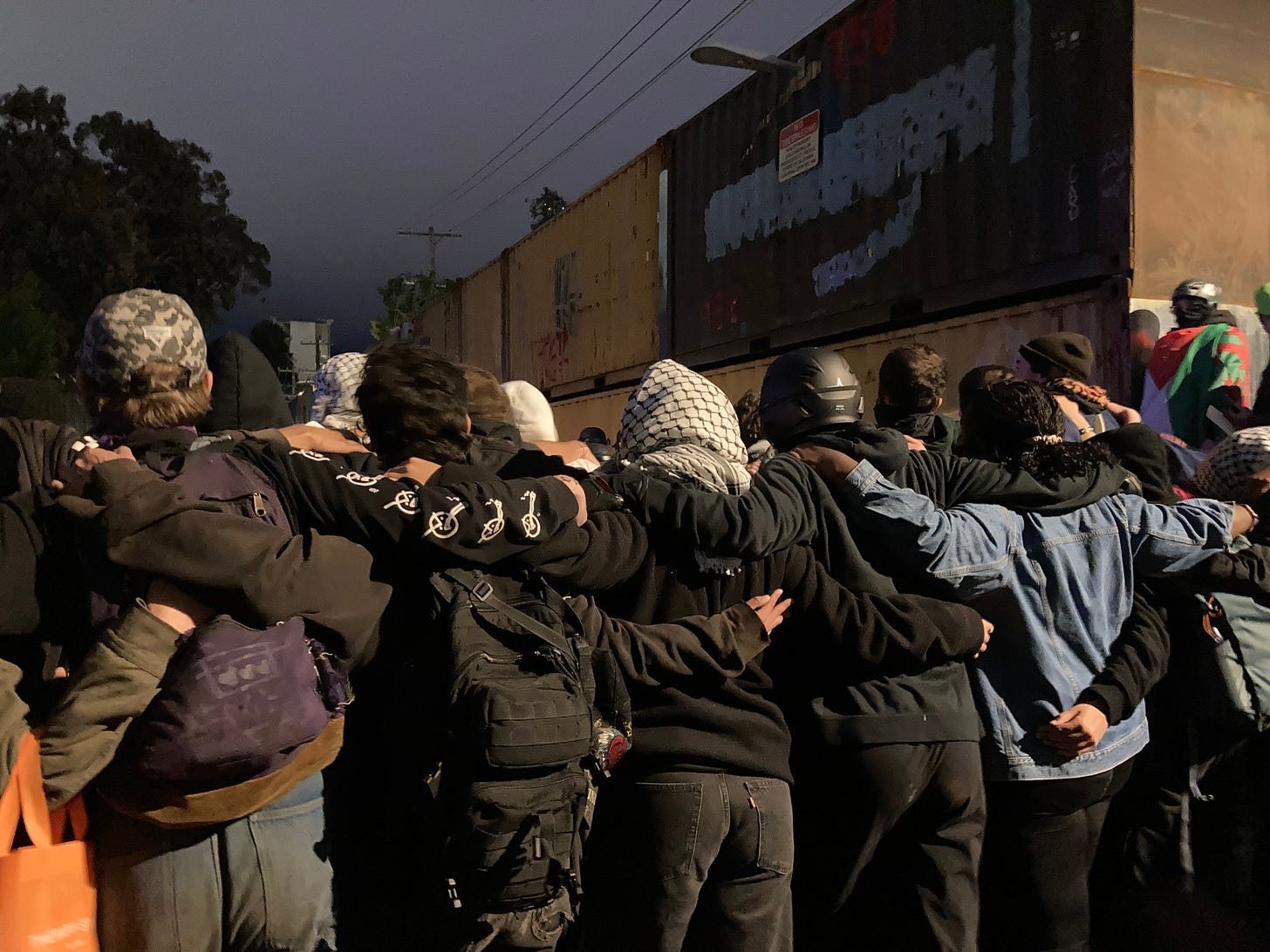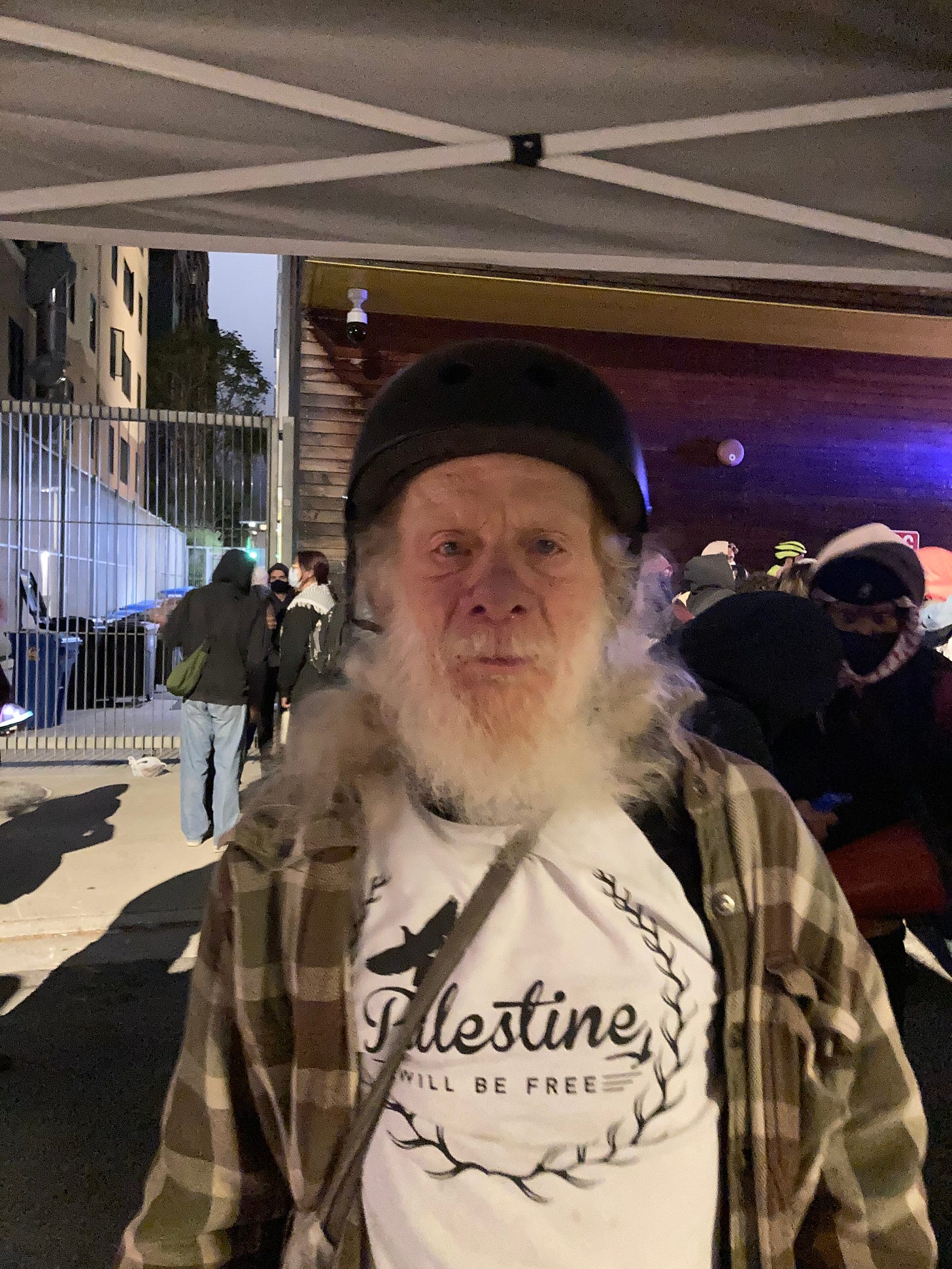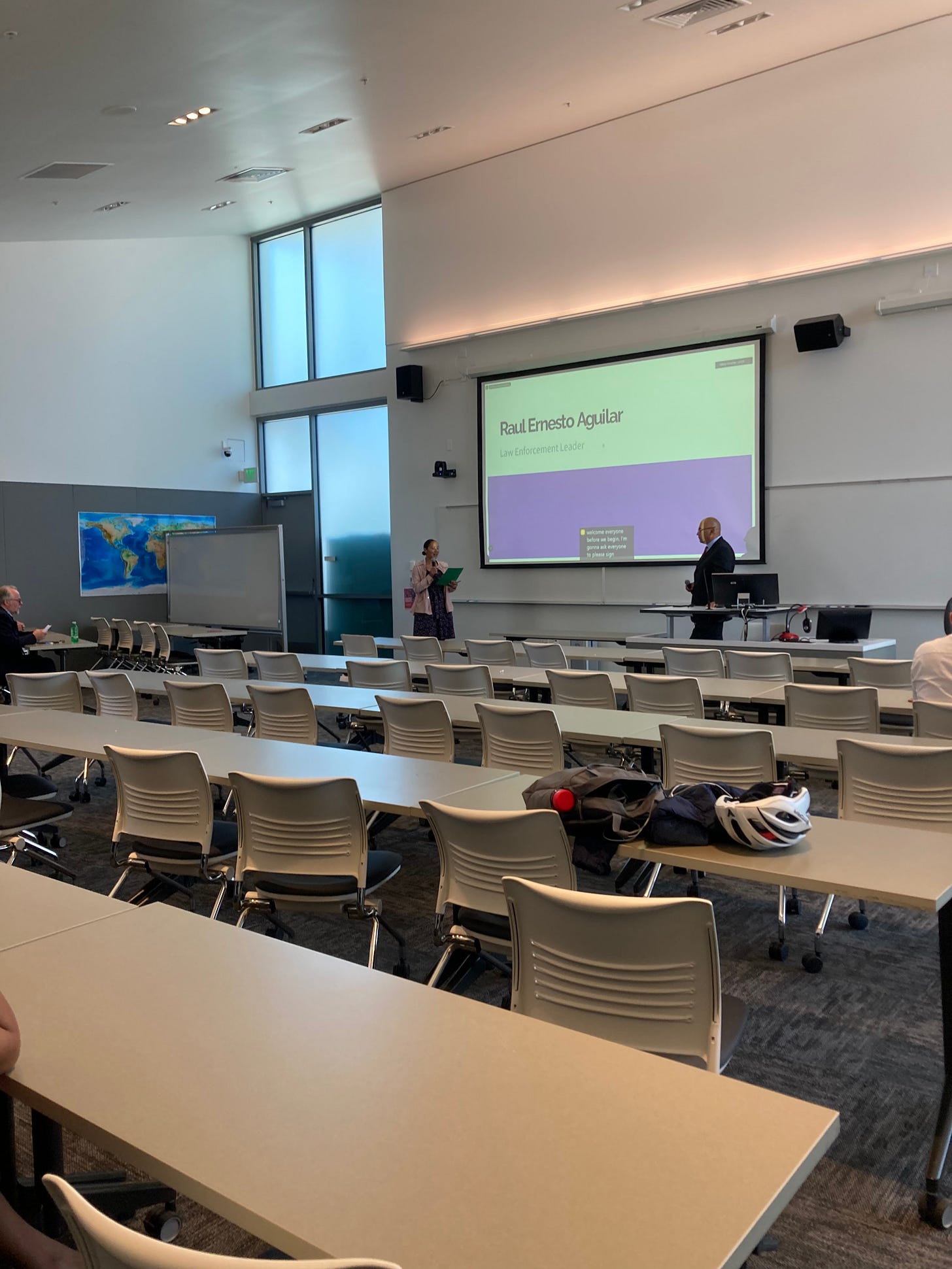"Billionaires Can't Stop Us!" From College of Marin To UC Berkeley, Bay Area Youth Are Sending A Consistent Message About Israel and US Policing
COM and UCB students have varying approaches even within their respective communities, but show solidarity on issues. Also: Huffman Hootenanny disrupted (days after he is queried on Margoliash case)
Photo: Youths link arms-over-shoulders in an attempt to block a police van from transporting nonviolent pro-Palestinian protesters from Berkeley to Santa Rita Jail last Thursday night. Photo by Eva Chrysanthe.
1.Berkeley
On Thursday evening, one day after Sonoma State University President Mike Lee was placed on leave (and subsequently "retired") for negotiating a brave agreement with students who had been protesting Israel's ongoing genocide, I received an urgent text from a reader in Marin County. The reader asked me to check out what was happening in Berkeley, where over 100 police were converging on activists who had taken over Anna Head Alumnae Hall, a shuttered building owned by the University of California. I made my way to the Berkeley campus, reaching the barricade outside AHA Hall just after 8 pm.
Barricade at Channing, Photo by Eva Chrysanthe. (Note officer’s resemblance to Rick Moranis as Dark Helmet in Mel Brooks’ “Spaceballs” satire.)
The occupation of AHA Hall had begun one day after the tightly organized student encampment at UC Berkeley had ended. Depending on your perspective, the UC encampment wrapped with great success or total disappointment. The organizers had negotiated a deal with the University, which agreed to demand a ceasefire and "begin talks around withdrawing investments from certain industries like weapons manufacturers” as reported by Supriya Yelimeli in Berkeleyside.
This agreement was not entirely satisfying to another group of activists, which included at least some Cal students. This second group set up an encampment at the abandoned Anna Head Alumnae Hall, not far from the now-closed Peoples Park. There, they later renamed the building Hind's Hall, in honor of Hind Rajab, a six-year-old Palestinian girl killed by the IDF, among the over 15,000 Palestinian children killed in Israel’s post-October 7 assault.
A text I received from one longtime Berkeley activist expressed concern for the safety of the second group, as they were less organized and did not appear to have a plan. Sometime early in the AHA/Hind’s Hall occupation, someone from the occupying group spraypainted on the walls a message that conflated Zionism with Nazism — and, of deeper concern, the Star of David with a swastika. This drew an immediate and sharp rebuke from activists in Berkeley. You could see a familiar faultline, with a group of activists differing on tactics, strategy, and messaging
Graffiti on Wall on Haste Street: “This is 4 Hind”, Photo by Eva Chrysanthe
But on Thursday night, when I reached the police perimeter on Haste Street, I saw many young organizers who had been critical of the AHA Hall occupiers standing in attendance outside the protest, as they deemed it necessary to monitor the police activity and show support for the larger issues the protesters brought forward. One Asian American Cal student was openly contemptuous of the AHA Hall protesters for the graffiti incident, and for what he called their failure to consult Palestinian activists. (At one point, he dismissed them as "white anarchists", perhaps unaware of the late 19th and early 20th century Bay Area history that linked white, Asian, and Latino anarchists, some of which is described in Kenyon Zimmer's lively book, photo below.) Yet he and his partner were still out there at approximately 10:30 p.m. to monitor. Like a group of older siblings, the "respectable" protesters still showed up for their "errant" family - though not without criticism.
(Above photo: Kenyon Zimmer’s lively book, which is not limited to Yiddish and Italian anarchists.)
Several young elected officials in Berkeley (Nathan Mizell, Soli Alpert, and Cecilia Lunaparra among them) attended, apparently to ensure the safety of any constituents both inside and outside the police barricade. There were, notably, a few older activists present, at least one of whom, Rusty, a Vietnam veteran who is a longtime member of Veterans for Peace, was jabbed with a baton and thrown to the ground by police earlier in the evening.
I snagged Rusty for a photo as two police drones floated above us. Photo by Eva Chrysanthe
Unlike the night of the Peoples Park shutdown, I noticed a significant number of young Black student activists in attendance (and even two Black student athletes from Cal who stopped by briefly to casually observe on their way back from the frozen yogurt shop, every garment they wore emblazoned with the "Cal Berkeley" logo.)
This act of solidarity amongst activists on the larger issues (opposition to the ongoing genocide and resistance to overpolicing despite strenuous disagreements about tactics) was probably not meant as a statement, but it struck me as the night's main takeaway.
By 8:30 p.m., a large group of students had begun to stand arms-to-shoulder at the barricade on Haste Street to try to prevent a police van from moving arrested protesters to Santa Rita Jail. This interlocked human blockade was still in effect, by my photo records, for almost an hour. Then it was announced by someone in the crowd to be wary as the police were ready to kettle the group. And shortly before 9:30 p.m., the protesters began to recede from the barricade with no explanation. (From later discussions I learned that a decision had been made to focus attention on bailing out the protesters out of Santa Rita. The following day, we learned that the bail was set abnormally high.)
Unlike the Peoples Park shutdown, which involved over 1,000 police from many departments and lasted all night, this action was largely shut down by 10 pm and involved “only” over 100 police officers – but local East Bay reporters have raised valid questions about why Oakland Police were also called to a nonviolent Berkeley student protest.
2.College of Marin:
Monday’s Meet-and-Greet with a former narcotics officer attracted a less-than-full-house, photo by Eva Chrysanthe
On Monday, something unusual happened at a meeting of College of Marin's "Campus Policing and Public Safety Advisory Council" (CPPSAC), which occurred immediately after a "town hall"-type event where students were introduced to Raul Ernesto Aguilar, an ex-SRPD narcotics unit officer who is in the running to be the next Chief of College of Marin’s Police Department. (At the meeting to introduce Aguilar, students were cautioned by officials against recording, even though there is no legal restriction against recording public meetings. So much for open government!)
The CPPSAC itself is a COM-appointed group that only recently became compliant with Brown Act requirements for transparency. Meetings prior to January were private and not accessible to the public, despite the valid public interest in policing on campus.
It was only following a complaint from a Black Marin resident late last year that the college determined that CPPSAC meetings should be made public, and it took COM until January 2024 to figure out how to do it.
Almost immediately upon the transition to transparency, CPPSAC's Curtis Aikens, the Food Network personality who is currently working for the police- adjacent Marin County Cooperation Team, announced his resignation from the Council. (Aikens has consistently been a pro-police voice in the County, having served on the County's conflict- laden AB 1185 Sheriff Civilian Oversight Working Group, with no disclosure of his son's serious 2022 use-of-force incident as a Sonoma County Sheriff Deputy.)
Making the meetings public had the benefit of discouraging members who were trying to cut deals with the County and police behind the scenes. This strengthened the position of those on the CPPSAC who actually wanted reform.
Thus, in May, CPPSAC members were finally able to place on the agenda an item to "discuss the current substation Lease Agreement with Marin County Sheriff on Kentfield Campus." The lease, which was first signed in 2015, generously gave the Marin Sheriff approximately 1,750 square feet of rental space for $1,125.52 per month, an amount that was already far below market value.
The discussion of the item occupied most of two-hour meeting in a small and stuffy room. Unsurprisingly, the debate split amongst generational and racial lines. All of those who voted yes on the proposed motion to recommend to the College of Marin President that the lease be terminated fit into one or more of the following categories: young, female, Black, Latino.
Meanwhile, Sheriff Hype-Man™️ and CPPSAC member Mark Dale played his usual role insisting that the discounted lease was a matter of being a "good neighbor" to the Sheriff, without disclosing what aspect of being a good neighbor, if any, the Sheriff was providing to the college. In fact, the only two members who argued against the resolution were both white, male, and middle-aged, and by the meeting's end, they were able to sway the vote of a older Asian American COM staffer.
Thus the vote was 8-3, with one abstention. This ratio was one vote shy of the 9 votes needed to pass.
This came as a blow to the many young people who had spoken eloquently throughout the meeting about their issues with the Sheriff substation. They rightly pointed out that the campus already has its own police department. They shared concerns not only about the conduct of Marin Sheriff deputies on campus, but about the Sheriff's cooperation with ICE. This cooperation puts at risk Latino residents, many of whom are students at College of Marin.
It was interesting that no one seemed to emphasize the elephant in the room -– that the college was getting ripped off by the already over-funded Marin Sheriff in the deal. In a County that struggles with affordable housing, the units occupied by the Sheriff could easily provide temporary shelter or be built into actual housing for struggling students, many of whom live in their cars.
Despite the missing vote, it was impossible not to see how much progress the younger CPPSAC members had made in the very short period of time (less than five months!) since the CPPSAC meetings were opened to the public. This was the first time that the item had made it onto the agenda; it was not necessarily the last. The lease itself ends in 2025, and whether it is renewed or not will be impacted by what the CPPSAC can do in the intervening months.
Why does the sheriff substation on campus even matter to "Kids Today™️"?
Aside from the specific concerns listed by the students, the Sheriff lease vote came less than two weeks after police stood by as peaceful pro-Palestinian protesters at UCLA were viciously beaten by pro-Israel counterprotesters. (Those counterprotesters, it was later revealed, were funded by billionaire Bill Ackman and the wife of comedian, Jerry Seinfeld.)
Young people, who overwhelmingly favor a ceasefire for their age peers in Gaza, are seeing police either assault peaceful pro-Palestinian protesters (as happened at Columbia University, the University of Texas at Austin, and countless other universities) or simply stand by and do nothing when counterprotesters attack them. It's “Uvalde-esque.”
And just a few days after the College of Marin vote, The Washington Post reported:
“A group of billionaires and business titans working to shape U.S. public opinion of the war in Gaza privately pressed New York City's mayor last month to send police to disperse pro-Palestinian protests at Columbia University... Business executives including Kind snack company founder Daniel Lubetzky, hedge fund manager Daniel Loeb, billionaire Len Blavatnik and real estate investor Joseph Sitt held a Zoom video call on April 26 with Mayor Eric Adams (D), about a week after the mayor first sent New York police to Columbia’s campus…. During the call, some attendees discussed making political donations to Adams, as well as how the chat group’s members could pressure Columbia’s president and trustees to permit the mayor to send police to the campus to handle protesters, according to chat messages summarizing the conversation.”
One of the most alarming images from the police abuses at college protests was from California. It shows police officers pointing guns directly at peaceful student protesters at UC Irvine. Today’s college students grew up being put through "active-shooter drills", and many have suffered deep anxiety both about guns, and about the reality that police, for all the funding they extract from institutions like colleges, are not making anyone safer. And now armies of police are directly attacking students. Yikes.
The matter of COM's steeply discounted lease is an ongoing story that I'll continue to update.
3.Huffman Event Disrupted:
On Monday, pro-Palestinian activists of all ages from Marin and Sonoma disrupted a campaign event for Congressman Jared Huffman held at the Lagunitas Brewery in Petaluma. (Lagunitas is now owned by Heineken, which is interesting given that Heineken is apparently profiting from slave labor in Brazil.)
Huffman's protesters were stationed both inside and outside the event. This occurred just three days after a constituent meeting with Huffman, during which he was questioned about his votes regarding additional funding for Israel and the lack of hate crimes investigation in the first-night-of-Ramadan assault on the Islamic Center of North Marin. Some of Huffman's responses to questions about the Margoliash case were alarming; I plan to ask the Congressman to clarify those statements prior to the next article.
Another update: I was contacted over the past few days by a relative of defendant David Margoliash. In a series of emails, the relative maintained that the attack on the Islamic Center should not be viewed as a hate crime due to the defendant’s mental illness. This is consonant with the position that a Marin I-J reporter, Cameron MacDonald, maintained in a discussion outside the courtroom a few weeks ago. Yet that argument itself raises questions about the racial disparities inherent in "mental health diversion". More on how those MHD disparities play out in Marin County in the next article.
Lastly: as I was wrapping this article for publication, I was informed that award-winning investigative journalist Peter Byrne is writing an article dealing with the disruption at the Huffman event and more. I'm excited to read that and will link to it when it comes out.
©️2024 Eva Chrysanthe








